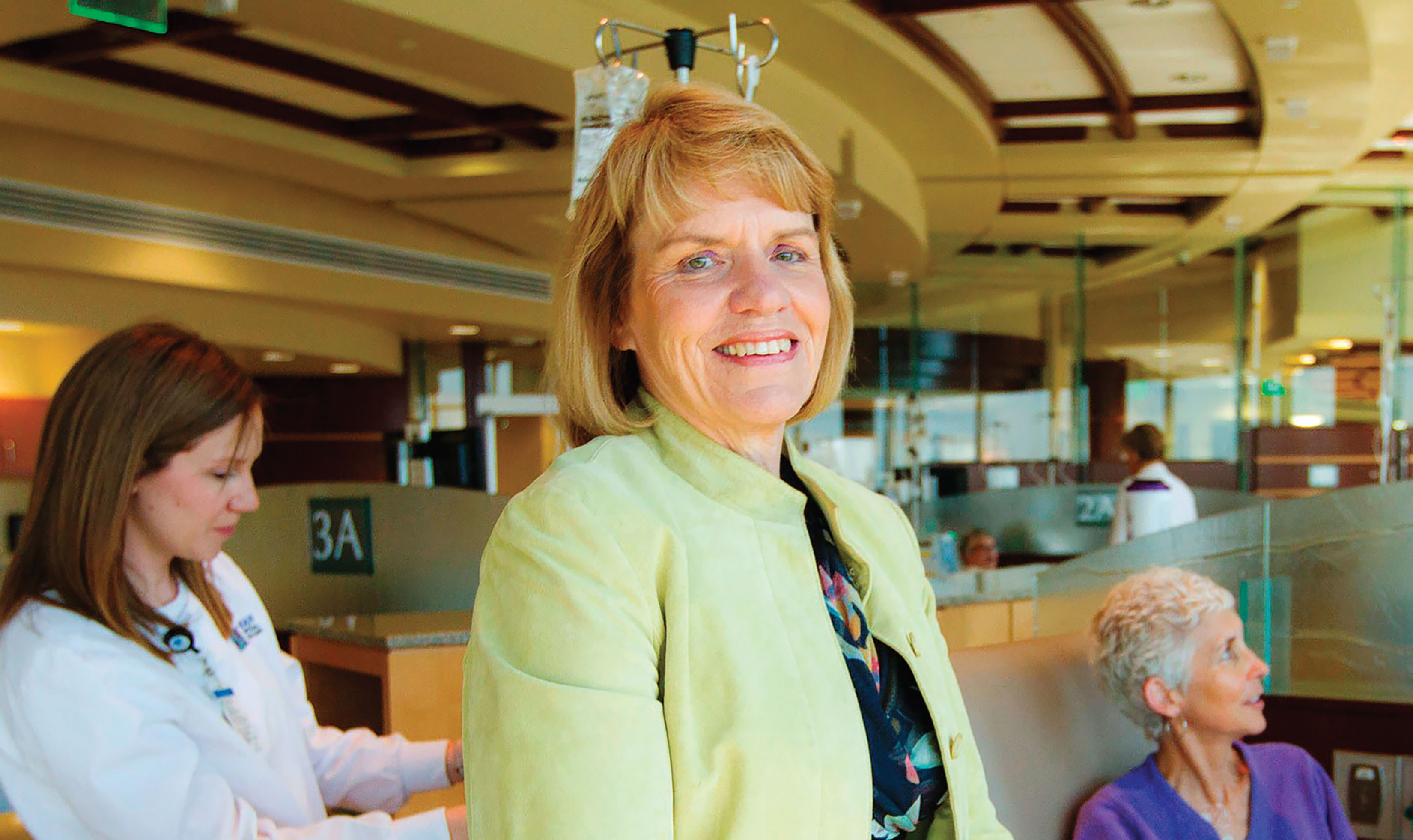Technology in Cancer Care
Technology is synonymous with modern-day health care, and the experiences of 2020 have shown that telehealth allows clinicians to provide care (https://doi.org/10.4338/ACI-2009-12-R-0020) along every inch of the cancer continuum. Although we’ve seen it used most recently to provide continuity of care from the safety of patients’ homes, one of telehealth's bigger purposes is overcoming geographic and practical disparities to enable more patients to access quality cancer care.

“Telehealth has enormous promise to overcome barriers to healthcare access and provide increased monitoring compared to our current episodic approach to health care,” ONS member Kathi Mooney, PhD, RN, FAAN, Louis S. Peery and Janet B. Peery presidential endowed chair in nursing and distinguished professor of nursing at the University of Utah, coleader of cancer control and population sciences at Huntsman Cancer Institute, and member of the Intermountain ONS Chapter, all in Salt Lake City, UT, said.
“Telehealth enables us to extend our reach and meet patients and caregivers where they are when they need us,” ONS member Abigail Baldwin Medsker, MSN, RN, OCN®, associate director of Memorial Sloan Kettering Cancer Center’s Digital Transformation Office in New York, NY, and member of the New York City ONS Chapter, said. “It really enables us to transition the traditional brick-and-mortar care into the home, including providing timely symptom management and end-of-life care.”

Advancements in Telehealth
“Technology moves fast, and historically, the healthcare space, specifically hospitals, has been slow on the uptake,” Baldwin Medsker said. “Over the past serval years, however, and now with the pandemic, we have seen the development, adoption, and integration of many new technologies.”
- Virtual reality for managing patients (https://doi.org/10.3390/jcm7030042) with anxiety and depression
- Artificial intelligence algorithms (https://doi.org/10.7861/futurehosp.6-2-94) to diagnose and screen for cancer
- Store-and-forward technologies (https://doi.org/10.4338/ACI-2009-12-R-0020) for at-home monitoring and image transfer
- Telepathology
- Telegenetics
“We are just scratching the surface on how these technologies can support the diagnosis and treatment of cancer, cancer prevention, and any other component of the cancer journey both within our institutions or while a patient is at home,” Baldwin Medsker said. “Wide adoption and ensuring accuracy will take time.”
Telehealth in Home Care
Mooney and her colleague Susan Beck, PhD, APRN, FAAN, led nursing innovation two decades ago when they developed Symptom Care@Home (SCH), a remote automated system to monitor (https://voice.ons.org/news-and-views/telehealth-programs-improve-symptom-management-at-home) patients with cancer between clinic visits and chemotherapy infusions.
“We were concerned about poorly controlled symptoms that patients experienced at home and their reliance on emergency department visits for symptom care,” Mooney said. “Traditional telephone triage did not seem to be working, and we thought that making home symptom assessment routine and systematic, not relying on the patient to initiate a call, might improve symptom outcomes.”
SCH integrates an interactive voice response system with a web-based symptom management system. It doesn’t require (https://doi.org/10.1097/CIN.0000000000000364) an internet connection or smartphone because it is delivered on an interactive voice response platform that allows patients to use the digital keys on any phone to input their answers.
“We tested and refined the system, which now includes daily assessment of common cancer symptoms, provides automated and immediate self-management coaching tailored to the exact symptoms and severity levels reported, and notifies providers of poorly controlled symptoms,” Mooney said. She explained that oncology nurse practitioners receive patients’ symptom notifications and respond using a web-based decision support system that guides them through additional areas to assess based on the symptoms reported and provides algorithms for intensifying symptom care based on evidence-based guidelines.
“We have recently also developed both web-based tablet and mobile app versions of SCH so patients can choose whichever approach they prefer,” she continued. “Measurement has demonstrated that SCH significantly lowers symptoms burden and improves physical functioning.”
Mooney and Baldwin Medsker both said that nursing innovation has no limit when it comes to propelling health care.
“Oncology nurses and nurse practitioners have the opportunity to advocate and assist in the development of telehealth technologies that would help them move some clinic-, office-, and hospital-based nursing care to the home,” Mooney said. “We should be the early leaders in testing and demonstrating how cancer care can be improved through innovative approaches to care at home.”
Challenges and Barriers
Mooney and Baldwin Medsker both said that practices should be cautious but proactive when implementing telehealth into clinical care. Testing products to determine their benefit and making sure they would actually add value to the lives of patients with cancer are important considerations, Mooney added.
“We can’t overwhelm patients with too much technology,” she said. “To benefit from technology assistance, we must be willing to adapt our care routines and incorporate new monitoring approaches into daily workflows. Telehealth is an adjunct to oncology care. It extends oncology nursing and our care to patients and families at home who otherwise would be alone. It does not replace our interaction with patients, but it allows us to be there for patients who notify us when they need additional support.”
Baldwin Medsker urged nursing leaders to consider the multifaceted effect of increased technology in health care, such as patient safety, digital literacy barriers, fear and acceptability of telehealth, and access to technology.
“When we store digital health data in databases or in the cloud, it enables us to create a better picture of our patients ensuring we are taking a holistic approach to providing care,” she said. “Having access to accurate patient data can help us have a clearer understanding of cost implications and associated reimbursement rates. By storing data, leveraging advanced analytics, and partnering with insurance providers, we can see how treatments affect outcomes.”
But when providers have access to that data, others may too. In 2018, to address concerns over patient safety California implemented the California Consumer Privacy Act, which focuses on data protection and privacy. It is considered (https://www.americanbar.org/groups/business_law/publications/committee_newsletters/bcl/2019/201902/fa_9) the toughest data privacy law in the United States and could become the model for protecting patients and their digital medical records.
“Our patients are protected by the Health Insurance Portability and Accountability Act (HIPPA) regulations. However, HIPAA was written prior to the introduction of most modern technologies, and many state and federal lawmakers are currently working to revamp and reimagine our privacy rules,” Baldwin Medsker said. “I think it’s important to be proactive and have a multipronged approach that includes such things as having a robust information security program and framework, providing education and training to your staff on this important topic, and implementing varying access privileges based on role.”
What the Research Shows
Even with the challenge of digital illiteracy among older patient populations and safety concerns like data breaches, telehealth has improved the lives of countless patients and practitioners across all areas of health care. With telehealth, patients have (https://pubmed.ncbi.nlm.nih.gov/26065105):
- 38% fewer hospital admissions
- 31% fewer hospital readmissions
- 63% greater likelihood of spending fewer days in the hospital
- More engagement in their care
“Telehealth facilitates better communication between patients, caregivers, and clinical team members. It has become a core component of delivering quality effective cancer care,” Baldwin Medsker said. “Technology has become part of the care team, and nursing leaders are uniquely positioned to serve a significant role in leading and influencing the transformation that we are seeing in the cancer care space.”
